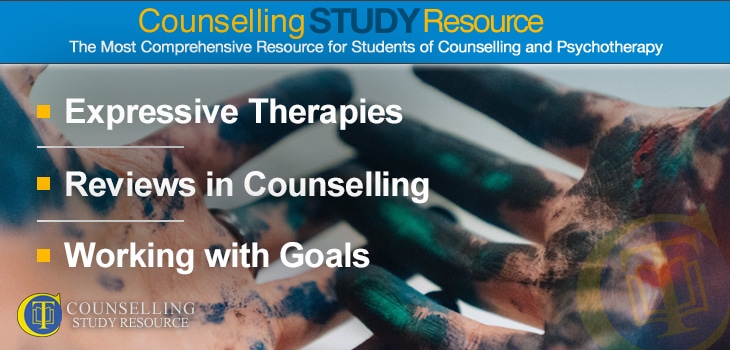068 – Expressive Therapies – Reviews in Counselling – Working with Goals
In episode 68 of the Counselling Tutor Podcast, Ken Kelly and Rory Lees-Oakes talk about the strengths and hazards of expressive therapy, before ‘Practice Matters’ examines reviews in counselling. Then, the presenters discuss goal-setting with clients.
Expressive Therapies (starts at 2.05 mins)
Expressive therapies include the use of art, drama and music in counselling. They were originally developed by Natalie Rogers, the daughter of Carl Rogers. He described her as ‘ploughing new ground’ in this respect.
Expressive therapies are often used on residentials for student counsellors; one exercise that Rory and Ken have used in this context is painting masks to show the (outer) face that you show the world and the (inner) face that you see yourself.
Expressive therapies can be very powerfully emotional, showing clients – very suddenly and strikingly – important things about themselves. As this can feel overwhelming to the client, it is important to prepare them for this level of revelation and impact. Another possible hazard is that some clients might find it hard to get involved if they believe they are not at all artistic. The activity can bring back difficult memories of childhood and school. It is important to reassure clients that it’s not about producing an amazing work of art, but rather about creating something that has meaning to them. It’s also important not to force clients to engage in expressive work, but to build trust and the therapeutic relationship before offering them this possibility in an open way, so they can refuse if they so wish.
Expressive therapies are particularly useful when working with children, who may find it harder than adults to express in words what they are feeling and thinking. In this context, the products of the creative activity can also be used (with the permission of the young person) to show parents, so giving them insight into their child.
It is vital to be qualified and to have undertaken continuing professional development in how to use expressive therapies safely before attempting to do so with clients.
Reviews in Counselling (starts at 13.11 mins)
Some counsellors favour doing regular reviews with clients (usually every six sessions), while some who practise the classical person-centred approach feel that this risks coming from the therapist’s – rather than the client’s – frame of reference. Reviews are commonly used in both transactional analysis and cognitive behavioural therapy (CBT), and in healthcare settings.
A review aims to find out how therapy has affected the client, and in particular what has changed as a result. It can also help inform how the client would like future sessions to be used. It can be particularly useful when the number of sessions is limited, though it is important not to make too much of the number remaining, as this could pressurise the client. Sometimes, measurement tools (such as CORE forms) are used to give a quantitative score reflecting how the client is feeling.
Rory offers a number of tips on reviewing in counselling:
- Do mention to the client when contracting that you plan to do reviews, and check how they feel about this.
- Make it clear to the client that you will not be reviewing their ‘performance’ – in other words, it’s just to see where they feel they’re at, not measuring how well they have done.
- Explain that the review also offers them the chance to ask for what they want from future sessions.
- Ideally, give at least one session’s notice of a review, so that the client isn’t caught unawares.
- If, when the planned day for the review comes, the client has something urgent they want to talk about instead, let them do so and save the review for the next time.
- Make sure you listen openly to how the client feels they’ve changed: what seems like a tiny change to you may be huge for the client.
- If the client has been spontaneously reviewing as they’ve gone along, there may be no need for a specific review.
- Be gentle and respectful – and remember that therapy is a process, not an event.
Working with Goals (starts at 23.52 mins)
Carl Rogers believed that all behaviour is goal-directed. Rory refers to the adage that ‘without a goal, you cannot score’. While goal-setting is associated more strongly with some modalities than with others, it can be useful in any type of therapy to ask the client what they would like to work towards changing. This can help the therapist and client to work to a common goal.
A potential downside of goal-setting, however, is that a client who likes to please people may state a goal that they believe is what the therapist wishes to hear. Some goals may also be too ambitious and be unrealistic (this trait could in itself form part of the client’s process that you could then look at in therapy). Also, some clients may not be honest if they feel they have not achieved their goal and/or may feel a failure in this situation. If goal-setting is to be used in counselling, it must therefore be applied with care.


